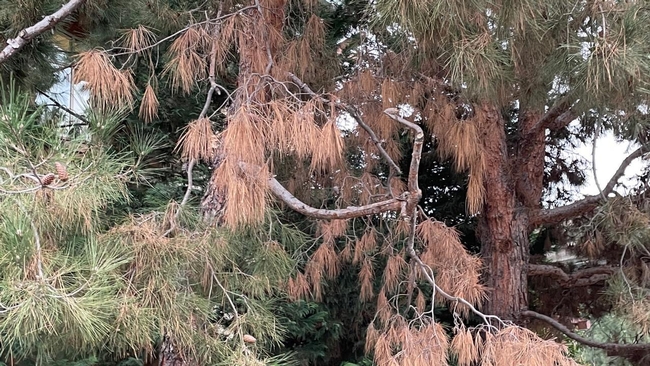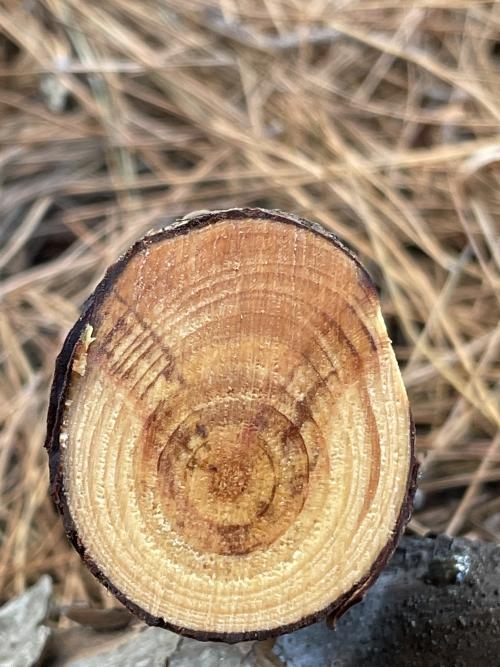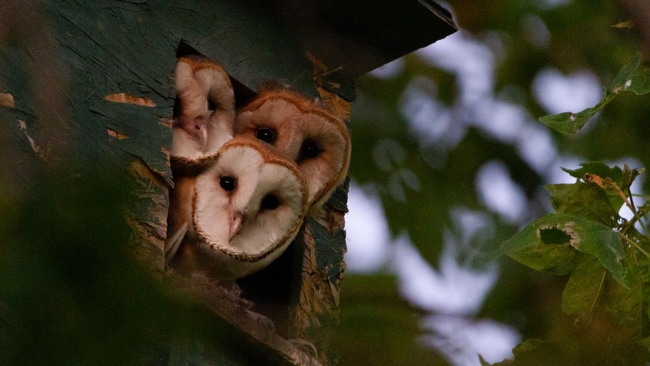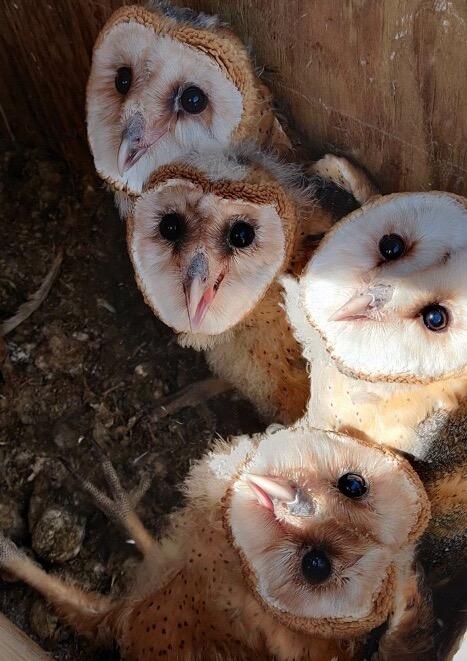Posts Tagged: dooley
Fungi that causes pine ghost canker detected in Southern California trees
Pathogen native to U.S. but had not infected pines until recently
Fungal pathogens that cause die-back in grape, avocado, citrus, nut and other crops has found a new host and is infecting conifer trees causing pine ghost canker in urban forest areas of Southern California.
The canker can be deadly to trees.
Scientists from University of California, Davis, first spotted evidence that the pathogens had moved to pines during a routine examination of trees in Orange County. Over four years, they found that more than 30 mature pines had been infected in an area of nearly 100 acres, according to a report in the journal Plant Disease.
Akif Eskalen, a professor of Cooperative Extension in the Department of Plant Pathology at UC Davis, suspects drought and other stress conditions brought on by climate change weakened the tree species, making it more susceptible to new threats.
“We have been seeing this on pine trees for the last several years,” he said. “Our common crop pathogens are finding new hosts.”
Pine ghost canker – caused by the fungal pathogens Neofusicoccum mediterraneum and Neofusicoccum parvum – usually infects the lower part of a tree's canopy, killing branches before moving on to the trunks. This dieback in some cases can be deadly.
Points of entry
The pathogens infect a tree by entering through wounds caused by either insects such as red-haired pine bark beetles or pruning – meaning trees in managed or landscaped areas could be at risk. Another route is via tiny natural openings known as lenticels that fungi can make their way through, said Marcelo Bustamante, a Ph.D. candidate in Eskalen's lab who is first author on the paper.
Spores from the fungi can disperse and the higher the prevalence means an increased chance of transmission. Rain, irrigation water and humidity by fog can trigger the right circumstances for the spores to spread, he said.
“The detection of these pathogens in urban forests raises concerns of potential spillover events to other forest and agricultural hosts in Southern California,” Bustamante and others wrote in the report.
Dead branches can indicate a canker. Detecting the fungi is not an emergency but “people should keep an eye on their plants when they see abnormalities,” Eskalen said.
Cankers are localized areas on stems, branches and tree trunks that are usually dead, discolored and sunken. On bark, the spores can look like strings of discolored dots.
The lab has posted a brochure bout how to best manage wood canker diseases.
Tips include:
* Keep your trees healthy: Proper irrigation and maintenance will keep trees strong.
* Prune dead branches to reduce sources of infestation.
* Avoid unnecessary pruning; perform structural pruning only.
Karina Elfar, Molly Arreguin, Carissa Chiang, Samuel Wells and Karen Alarcon from the Department of Plant Pathology contributed to the paper, as did experts from Disneyland Resort Horticulture Department, State University of New York's College of Environmental Science and Forestry, UC Irvine and UC Los Angeles.
Fall is best time to clean nest boxes for barn owls
Research shows land managers should clean nest boxes in autumn to avoid disturbing the raptors
When it comes to American barn owls, forget spring cleaning.
The best time of year to clean out nest boxes to ready them for breeding pairs is the fall months of September through November, according to research out of the University of California, Davis, that analyzed nearly a century of banding and other records.
In a paper published in the Journal of Wildlife Management, researchers found that the median egg laying date for barn owls (Tyto furcata) in California is Feb. 20, so cleaning nest boxes in the fall is recommended.
“The risk is you could disrupt a nest that has already started,” said lead author Ryan Bourbour, a Ph.D. candidate in ecology in the Department of Animal Science at the time of the study. “We want to reduce disturbances to nesting pairs even in the weeks prior to egg laying.”
American barn owls offer a natural way for land managers and agricultural operations to control pests, because the raptors eat mice, gophers and rats. One breeding pair can consume up to 2,000 rodents annually, according to the UC Davis School of Veterinary Medicine.
But natural tree cavities and old barn structures are not as plentiful as they once were, so installing nest boxes can attract the barn owls. And land managers who spend money installing these “nest box networks” have long asked about the best time of year to do maintenance and cleaning. Planning cleaning and maintenance well before the start of the breeding season is “part of making that nest box worthwhile,” Bourbour said.
Pellets add up
After eggs hatch, nestlings spend their early days eating and living in the nest boxes until they are able to leave the nest, said Breanna Martinico, another paper author and an animal science Ph.D. candidate in ecology.
The nestling period of roughly 65 days is considered long.
“That's two months where owls are living and growing exclusively in that nest box,” said Martinico, who is also a UC Cooperative Extension human-wildlife interactions advisor in Napa, Lake and Solano counties.
As many as five or six nestlings are typically in a box, and they eat up to four or five rodents each day. Nestlings swallow their prey whole, and what isn't digested — fur and bones — is coughed up in round or oval-like pellets.
“They're in there for seven to eight weeks just regurgitating these pellets,” Bourbour said. “A lot of pellets pile up over the course of a breeding season and a lot of these boxes need to be cleaned out.”
From anecdotal to data
Discussions about how early the breeding season starts have mostly been anecdotal. To get a better picture, the paper's authors analyzed 96 years of banding records from the United States Geological Survey Bird Banding Lab and 39 years of intake records from California Raptor Center at UC Davis. Both databases helped them estimate the typical egg laying time of year in California, Martinico said.
Having this information can help land managers ensure maintenance is done and nest boxes are safe for the next breeding pair, helping barn owl populations while also benefiting agricultural operations.
“We can give them tools to manage barn owl nest box networks effectively and maximize pest control through owls,” Martinico said.
Additional co-authors include Emily Phillips, Jessica Schlarbaum and Joshua Hull in the Department of Animal Science, Michelle Hawkins in the Department of Medicine and Epidemiology at the UC Davis School of Veterinary Medicine and Sara Kross from Columbia University.
Funding came from the National Institute of Food and Agriculture's Western Sustainable Agriculture Research and Education program.
The journal article is entitled Banding records of nestling barn owls reveal optimal timing for nest box maintenance in California.
LA Times reports on state ag schools' budget woes
College agriculture programs will likely rely increasingly on public and private partnerships, UC ANR vice president Dan Dooley told the Los Angeles Times for an article on funding cuts to the state's preeminent agricultural education programs.
The article, which appears on the front page of the Times' website today, focused on Cal Poly Pomona, Fresno State and UC ag programs. State support for agricultural and natural resources at UC Berkeley, UC Davis and UC Riverside has dropped 15 to 20 percent in the last three years. At UC ANR, Dooley said, dozens of administrative and support positions have been eliminated, research has been cut, and some departments within colleges have been eliminated or consolidated.
Dooley expressed concern about the repercussions of reduced public investment in agricultural research and education.
"There's an enormous relationship between public investment in agricultural research and farm productivity," Dooley was quoted. "If we're going to play a significant role in meeting worldwide demand, including adjusting to climate change, we're going to have to enhance productivity.... California has always been the leader."
Times reporter Carla Rivera wrote that some of the state's ag schools are looking for creative ways to boost their budgets. At Fresno State and Cal Poly, ag departments are expanding beef, pork and wine sales to the public.
Fresno State is looking into growing its own animal feed to cut costs. The Pomona campus hosts a pumpkin festival, sells produce at local farmers markets and in the school's farm store, and is investing in higher quality horses, which are auctioned online for as much as $25,000. Cal Poly is also considering opening a petting zoo.
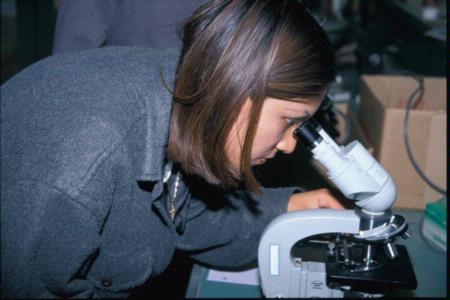
State funding cuts are striking deep at college agriculture programs in California.
Cuts loom for ag and extension programs nationwide
Agriculture and extension programs at land-grant universities around the nation are feeling the impact of university budget cuts, according to an Associated Press story that was picked up by several major newspapers.
“We’re mortgaging our future with some of these cuts,” the story quoted Ian Maw, vice president for food, agriculture and natural resources at the Association of Public and Land-grant Universities.
The story bore a Minneapolis dateline and began with the plight of the University of Minnesota Extension program.
"People may not see the impact tomorrow but they will see long-term that not investing now means we’ll have more problems in the future,” said Beverly Durgan, dean of the University of Minnesota Extension program.
Other universities covered included:
- University of Georgia, where the College of Agricultural and Environmental Sciences recently decided to lay off 18 workers and sell a farm
- Iowa State University, where the extension program is planning for a 6 percent reduction in state funding
- Pennsylvania State University, where extension expects a cut between $5.5 million an $8 million.
Reporter Steve Karnowski also spoke to Dan Dooley, the vice president of agriculture and natural resources for the University of California. Dooley said he expects agriculture at the Berkeley, Davis and Riverside campuses will be cut less than most programs once California’s $9.6 billion deficit is resolved, but it will be hurt.
“Final decisions haven’t been made but the reality is with each reduction we’re going to have to decide what we’re going to do and what we’re not going to do,” Dooley was quoted.
The story was picked up by the Washington Post, the San Francisco Chronicle, the Deseret News and, according to Google News, 168 other media outlets.
Dooley addresses extension budget woes on D.C. panel
Vice President of UC Agriculture and Natural Resources Dan Dooley, speaking at the Farm Foundation Forum in Washington, D.C., last month, proposed a new direction for funding research and teaching in agriculture, according to an article in Lancaster Farming.
He pointed to the 1944 GI Bill, the National Defense Education Act of 1956, and the Higher Education Act and Pell Grants of 1965 as examples of earlier notable federal initiatives.
For the 21st century, Dooley suggested a “Food Security and Sustainability Act," which could lead to funding for research projects and university-supported programs for agriculture.
Other panelists on the Farm Foundation Forum, which took place at the National Press Club, were former U.S. Rep. Charles Stenholm of Texas, Nicole Ballenger of the University of Wyoming and George Norton of Virginia Tech.
The Lancaster Farming article said the panelists agreed on a number of points:
- The well-being of the nation depends on a strong, pro-active agricultural system served by vibrant college and university agriculture programs
- "Business as usual” is over
- New sources of funding for agricultural training and research must be cultivated
- Rewards and opportunities are necessary to entice bright minds to do research and tackle the problems facing modern farming in the U.S.
- Extension services are the “face” of the university, and therefore their funding and their roles must be guarded
According to reporter Janice Booth, Dooley spoke about the state of agriculture programs at the University of California.
“Since 1990, there has been a 40 percent decline in (California’s) investment in education,” he said.
The segregation of agriculture services at the federal and university levels further impedes growth. At UC, colleges of agriculture are not integrated with the larger institution, and thus miss some of the opportunities to collaborate with other colleges in research and academic initiatives, Dooley said.


